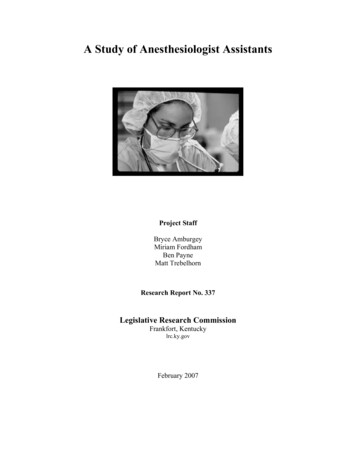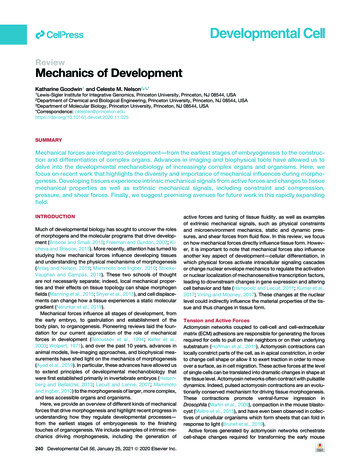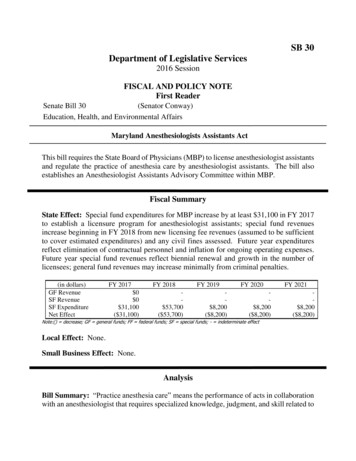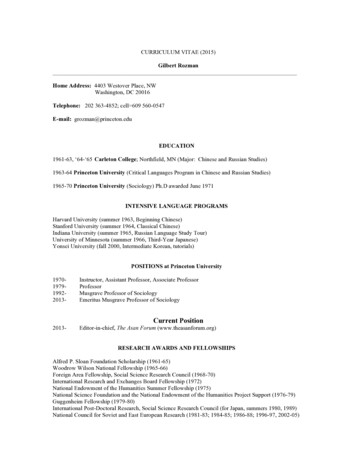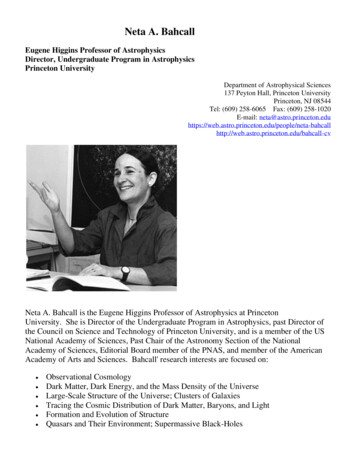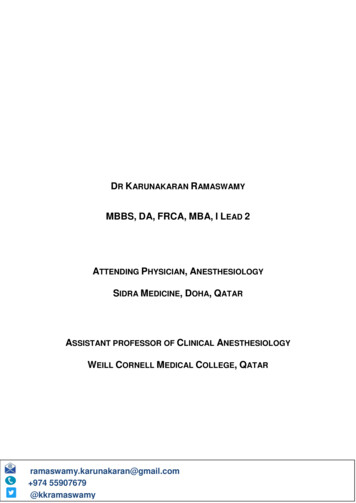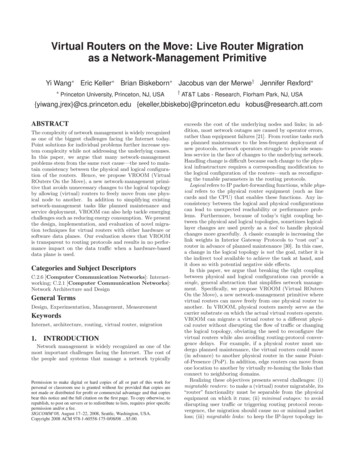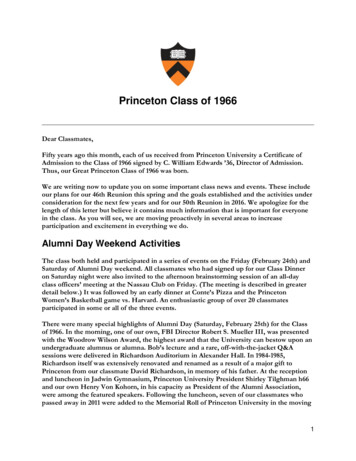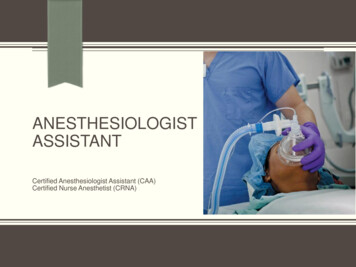
Transcription
ANESTHESIOLOGISTASSISTANTCertified Anesthesiologist Assistant (CAA)Certified Nurse Anesthetist (CRNA)
What is a Certified Anesthesiologist Assistant? Certified Anesthesiologist Assistants (CAAs) are highly skilled health professionals who work underthe direction of licensed anesthesiologists to implement anesthesia care plans. CAAs workexclusively within the anesthesia care team environment as described by the American Society ofAnesthesiologists (ASA). All CAAs possess a premedical background, a baccalaureate degree, andalso complete a comprehensive didactic and clinical program at the graduate school level. CAAsare trained extensively in the delivery and maintenance of quality anesthesia care as well asadvanced patient monitoring techniques. The goal of CAA education is to guide the transformationof qualified student applicants into competent health care practitioners who aspire to practice in theanesthesia care team. Certified Anesthesiologist Assistants and certified registered nurse anesthetists are both defined as"non-physician anesthetists" within the Centers for Medicare & Medicaid Services section of theCode of Federal Regulations.https://aaaa.memberclicks.net/
Educational Differences Between CAAs and Nurse AnesthetistsAlthough both are considered to be equivalent clinical non-physician anesthesia providers and mayserve as physician extenders in the delivery of anesthesia, CAAs and CRNAs are very different withregard to their educational background, training pathway and certification process.CAACRNA Bachelor’s degree with prerequisites typical ofpremedical coursework Take the MCAT or GRE A clinical background is ideal, but not required Minimum of 24-28 months in a Master’s levelprogram accredited by the CAAHEP, based at,or in collaboration with, a university that has amedical school and academic anesthesiologistphysician faculty, with at least one director thatis a licensed, board-certified anesthesiologist Each CAA program must have at least onedirector that is a licensed, board-certifiedanesthesiologist Main clinical sites must be academic medicalcenters Average of 600 hours class/lab, 2600 hours ofclinical anesthesia ed, and more than 600anesthetics administered, including all types ofsurgery Must have a bachelor’s degree in nursing oranother appropriate area and license to practiceas a registered nurse Take the GRE or MAT, prior to matriculation Minimum of 24 months in a Master’s levelprogram accredited by the COA, at any college oruniversity Minimum of 450 hours of class/lab, 800 hours ofclinical anesthesia ed, administration of 450anesthetics, including all types of surgeryhttps://aaaa.memberclicks.net/
What Do CAAs and CRNAs Do?Under the medical direction and supervision of an anesthesiologist, the CAAs functions include, butare not limited to, the following: Making the initial approach to a patient of any age in any setting to obtain a preliminarypreanesthetic health history, perform an appropriate preanesthetic physical examination and recordpertinent data in an organized and legible manner for review by an anesthesiologist. Theseactivities help to define the patient's current physical status as it relates to the planned anesthetic. Performing or assisting in the conduct of diagnostic laboratory and related studies as appropriate,such as drawing arterial and venous blood samples. Establishing noninvasive and invasive routine monitoring modalities as delegated by theresponsible anesthesiologist. Assisting in the application and interpretation of advanced monitoring techniques such aspulmonary artery catheterization, electroencephalographic spectral analysis, echocardiography andevoked potentials. Assisting in inducing, maintaining and altering anesthesia levels, administering adjunctive treatmentand providing continuity of anesthetic care into and during the postoperative recovery period.More CRNAs have the main responsibility of administering anesthesia and monitoring patients through theirsurgeries. CRNA functions also include, but are not limited to, the following: Completing physical assessments of each patientDiscussing the surgery and recovery with the patient prior to the procedurePreparing and administering the patient-specific amount of anesthesia needed for the procedureMaintaining the patient’s anesthesia levels during surgeryEnsuring proper anesthesia recovery for patients until patients are transferred to care unitsMore
Working Conditions and SalaryWorking Conditions Anesthesiologist assistants work in hospitals and surgery centers under the directionof a licensed anesthesiologist. The profession maintains a typical work week withoptions for on-call, evening or weekend assignments.Salary Range and Outlook Anesthesiologist assistants are in high demand, because of the need for skilledpersonnel to deliver anesthesia. Anesthesiologist assistants operate as physicianextenders, performing critical tasks that ensure the safety of the patient and promoteoptimal health outcomes.The average salary range for anesthesiologist assistants is 95,000-180,000.When employed within the same department and when possessing the same jobdescription and experience level within the anesthesia care team, CAAs and CRNAs arecompensated with identical salary and benefit packages. (per AAAA)https://aaaa.memberclicks.net/
Can CAAs and CRNAs Practice Without Supervision? In addition to the practical issues that limit how many anesthetists may be supervisedby an anesthesiologist at any one time, ratios are also often specified as contractrequirements from payors. For instance in order to meet the Centers for Medicare andMedicaid Services (CMS) requirements for medical direction, no more than 4anesthetists (CAAs or CRNAs) may be concurrently directed by an anesthesiologist. The supervision ratio may also be defined in state law or Board of Medicine guidelinesand is usually between 2:1 and 4:1. Check the regulations in your state for theapplicable standard. It is important to note that in states where statutes specify asupervision ratio of CAAs to anesthesiologists at less than 4:1, the anesthesiologistmay also concurrently supervise CRNAs up to a total combined ratio of 4:1 for bothnon-physician anesthetists. CMS recognizes both CRNAs and CAAs as non-physician anesthesia providers.Similarly, commercial insurance payors make no distinction between the twoanesthetist types with regard to payments for services provided under medicaldirection by an anesthesiologist. According to the United States Code of Federal Regulations: If the hospital furnishesanesthesia services, they must be provided in a well-organized manner under thedirection of a qualified doctor of medicine or osteopathy. The service is responsible forall anesthesia administered in the hospital.https://aaaa.memberclicks.net/
Where are CAAs Practicing?*CAAs may practice at any Veterans Affairs facility in all 50 stateshttps://aaaa.memberclicks.net/
Where are CRNAs Practicing?according to the Bureau of Labor Statistics
Why Should You Consider a Career as a CAA? Joining an Anesthesia Care Team as a CAA is an extremelyrewarding career. CAAs medically manage patientconditions under anesthesia, expand access and quality ofanesthesia care to rural and under-served areas, and areadvocates for patient safety. The job outlook for CAAs is very favorable. Many AAstudents receive multiple job offers before they evengraduate. The starting salary for CAAs is about 110,000annually, with generous sign on bonuses, an average of fiveweeks vacation each year, pension and profit sharing, andother excellent benefits.https://aaaa.memberclicks.net/
Why Become a CRNA? Certified Registered Nurse Anesthetists (CRNAs) are special people: compassionate, vigilantin their responsibilities, protective of and advocates for their patients. They dedicatethemselves to one patient at a time, watching over them and seeing that the patient is painfree during surgery.What makes someone want to dedicate their careers to the nurse anesthesiaprofession? Read about these amazing healthcare professionals in their own words.Mary Nguyen, DNP, CRNA CRNA since 2017 The decision came naturally Johnny Moore, CRNA CRNA since 1976 Not the most direct path Gloria Spires, BS, CRNA CRNA since 1975 My aunt, a surgical nurseinspired me Ryan Pettit, DNP, CRNA CRNA since 2015 I was in finance, until the stockmarket crashed More
CAA Educational Programs Emory University - Atlanta, Georgia Case Western Reserve University - Cleveland, Ohio Case Western Reserve University - Houston, Texas Case Western Reserve University - Washington, D.C. Indiana University - Indianapolis, IN South University - Savannah, Georgia Nova Southeastern University - Fort Lauderdale, Florida Nova Southeastern University - Tampa, Florida University of Missouri Kansas City - Kansas City, Missouri Quinnipiac University - Hamden, Connecticut University of Colorado - Aurora, Colorado Medical College of Wisconsin – Milwaukee, Wisconsinhttps://aaaa.memberclicks.net/
Reading of Potential Interest:Case Western Reserve University MS in Anesthesia NewsletterIn this issue:CWRU Shifts to More Holistic Admissions ProcessNew Location for Houston Allows for ExpansionSpring 2019 Health Professions Fairshttps://sway.office.com/WnU1r5E0KjJu7zwg?ref Link
Sample CAA Curriculumfrom the University of Missouri-Kansas CityYear 1 - Didactic PhaseSpringAnatomy for Anesthesiologist AssistantsProfessionalism for Anesthesiologist Assistants IPatient Monitoring and InstrumentationPhysiology for Anesthesiologist Assistants IIntroduction to AnesthesiaOrientation to Simulation & Clinical ApplicationPharmacology for Anesthesiologist Assistants IResearch Applications in MedicineSummerProfessionalism for Anesthesiologist Assistants IIMethods of Anesthesia IPhysiology for Anesthesiologist Assistants IIAnesthesia and Coexisting Disease IAnesthesia Clinical Experience IPhysiological Model-based Simulation IFallAnatomy for the Anesthesiologist Assistant IIProfessionalism for Anesthesiologist Assistants IIIAnesthesia and Coexisting Disease IIAnesthesia Clinical Experience IIPharmacology for Anesthesiologist Assistants IIMethods of Anesthesia IIPhysiological Model-based Simulation IIYear 2 - Clinical PhaseSpringAnesthesia Clinical Correlation IIAnesthesia Clinical Experience IIISummerAnesthesia Clinical Correlation IIIAnesthesia Clinical Experience IVFallAnesthesia Clinical Correlation IVAnesthesia Clinical Experience VYear 3 - Clinical PhaseSpringSenior SeminarAnesthesia Clinical Experience 38
Nurse Anesthesia Educational Programs Columbia School of Nursing, New York, NY Frances Payne Bolton School of Nursing, at Case Western, Cleveland, OH Yale School of Nurse Anesthesia, New Haven, CT University of Pennsylvania School of Nursing, Philadelphia, PA Mayo Clinic, Rochester, MN Drexel University College of Nursing and Health Professions, Philadelphia, PA Jefferson College of Nursing, Philadelphia, PA Boston College Connell School of Nursing, Chestnut Hill, s/CRNA-School-Search.aspx
Sample Nurse Anesthesia Program Curriculumfrom the University of PennsylvaniaYear 1SummerAdvanced Physiology and PathophysiologyBasic Principles of Nurse Anesthesia PracticeAdvanced Physical Assessment & Clinical Design MakingApplied Physiology for Nurse Anesthetists IFallPharmacology of Anesthetics and Accessory Drugs IBaci Principles of Nurse Anesthesia Practice IIAdvanced Pharmacology and Therapeutics for Nursing PracticeApplied Physiology for Nurse Anesthetists IIClinical Fieldwork for Nurse Anesthesia Practice ISpringCurrent Issues in Health and Social PolicyAdv. Principles of Nurse Anesthesia Practice:Obstetrics, Pediatrics, & Women of Childbearing AgeIntroduction to Research Methods and DesignApplied Science Related to AnesthesiaClinical Fieldwork for Nurse Anesthesia Practice IIYear 2SummerIntroduction to Principles and Methods of EpidemiologyAdvanced Principles of Nurse Anesthesia Practice:Cardiac, Vascular & Thoracic SurgeryClinical Fieldwork for Nurse Anesthesia Practice IIITranslating Research & Evidence into Pratice (DNP Project #1)FallAdv. Principles of Nurse Anesthesia Practice:Neurosurgery, Orthopedics, Pain Management & TraumaLeadership Development in HealthcareNurse Anesthesia Residency IDNP Project Planning (DNP Project #2)SpringAdvanced Principles of Nurse Anesthesia Practice: Specialty SurgeryPain, Science & PracticeData AnalyticsNurse Anesthesia Residency IIPrinciples & Practice of Quality Improvement &Patient Safety/Systems Thinking in Patient SafetyYear 3SummerNursing InformaticsNurse Anesthesia Residency IIIDNP Project Implementation (DNP Project #3)Professional Aspects & Leadership for Nurse Anesthesia PracticeFallConceptual & Theoretical Foundations of Advanced Nursing PracticeNurse Anesthesia Residency IVHealth Care Economics & Business PlanningDNP Project Evaluation & Dissemination (DNP Project #4)SpringNurse Anesthesia Residency ans-of-study/full-time/
The Certification Process for CAAs and CRNAs Upon completion of an accredited nurse anesthetist program, a student may become certified bypassing the Council for Certification of Nurse Anesthetists certification exam. This examination is anadaptive computer examination consisting of 90-160 questions. Forty hours of approved ContinuingEducation Units (CEU) are required every two years in order to recertify. To be recertified, nurseanesthetists are not required to pass any further testing. The NCCRNA has proposed a newrecertification process requiring CRNAs to pass a recertification exam every 8 years beginning in2015. If this measure is adopted all CRNAs will have passed a recertification exam by 2023. Upon completion of an accredited AA program, a student may become certified by passing theNCCAA examination. The examination is administered and scored by the National Board of MedicalExaminers as part of services contracted to NCCAA. Performance information for test items and theoverall exam are provided by NBME. NCCAA uses this data to set the passing score and providesnotification of certification. NCCAA awards a time-limited certificate to each candidate whosuccessfully completes the Certifying Examination. To re-certify, an AA must complete 40 hours of CME every two years and register the activities withNCCAA. Additionally, AAs must take the Continuing Demonstration of Qualification Exam every sixyears.https://aaaa.memberclicks.net/
For More Information American Academy of Anesthesiologists Assistants https://www.anesthetist.org/ The Association of Anesthesiologist Assistant Program Directors http://www.aaapd.org/ Anesthesia Patient Safety Foundation https://www.apsf.org/ Commission on Accreditation of Allied Health Education Programs https://www.caahep.org/ American Society of Anesthesiologists https://www.asahq.org/ National Commission for Certification of Anesthesiologist Assistants http://www.aa-nccaa.org/ American Association of Nurse Anesthetists https://www.aana.com/ The CRNA https://thecrna.com/ Registered Nurse RN https://www.registerednursern.com/
Bachelor's degree with prerequisites typical of premedical coursework Take the MCAT or GRE A clinical background is ideal, but not required . Must have a bachelor's degree in nursing or another appropriate area and license to practice as a registered nurse . Nova Southeastern University - Fort Lauderdale, Florida Nova Southeastern .
